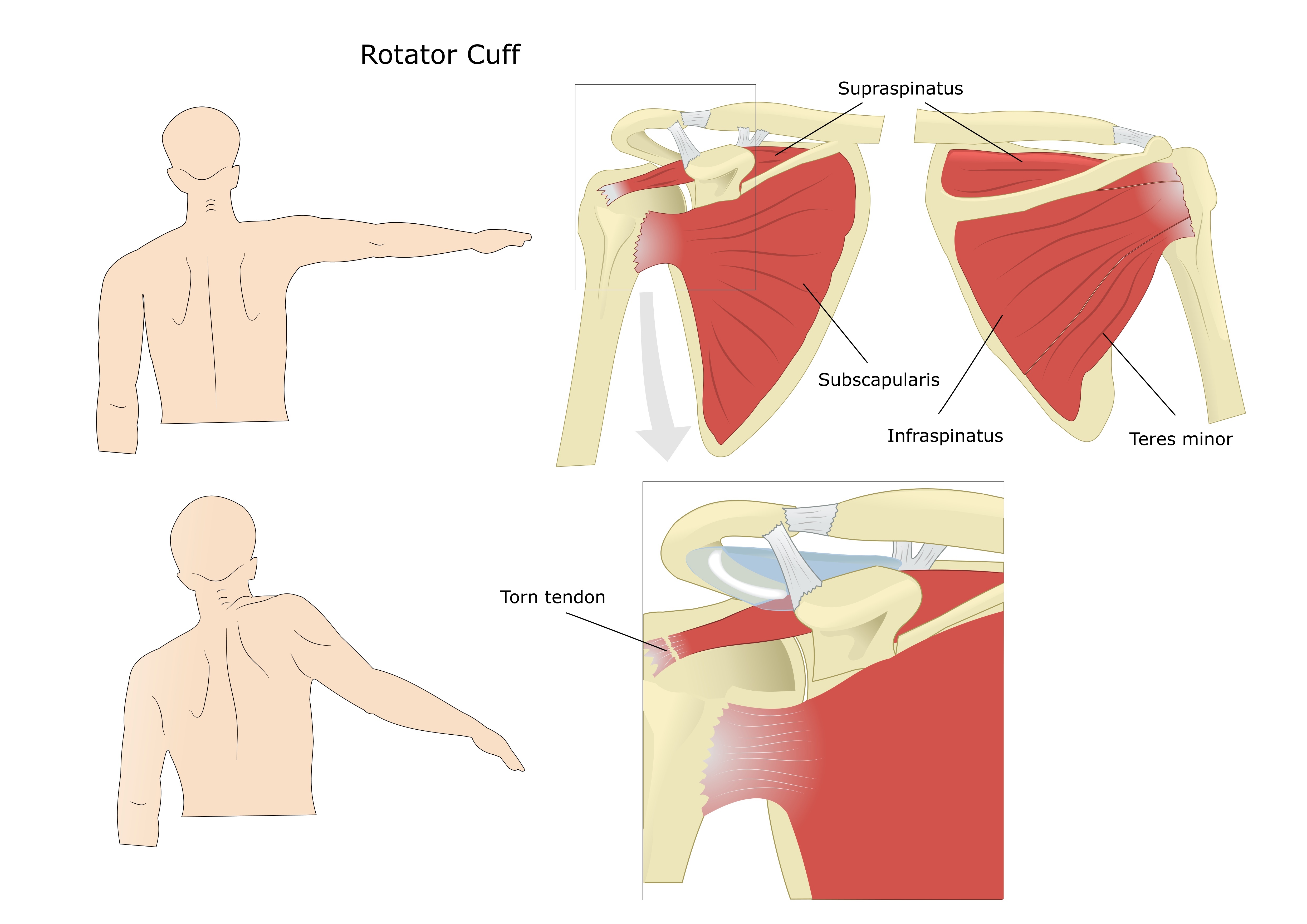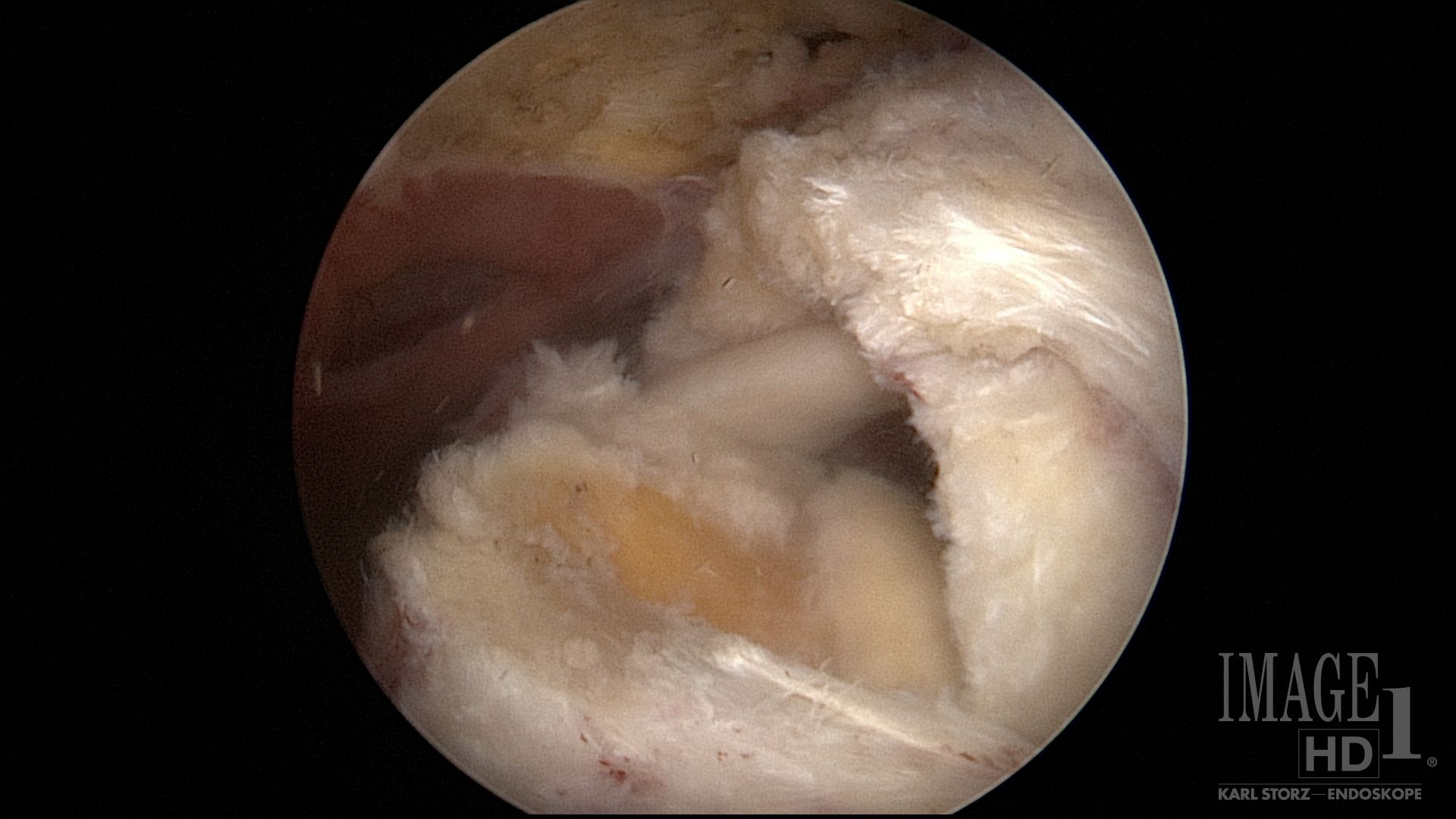Many people have heard the term “rotator cuff.” But what is the Rotator Cuff? And why do we worry about it so much? The rotator cuff is a common source of shoulder pain for a large percentage of the population. While many people develop rotator cuff tears without any specific injury, high-intensity interval training puts the shoulder at particular risk.
There are many reasons for this. But ultimately the main cause is “impingement.” When you combine poor posture with bad shoulder positioning and a lot of overhead activity, you have a recipe for rotator cuff disaster! Does this mean that you shouldn’t do these exercises? Of course not! It just means you should learn to do them right so you can avoid injury!
What is the Rotator Cuff?
The rotator cuff is a set of four muscles and tendons that encircle the shoulder itself. They start on the shoulder blade, and their tendons attach to the top, front, and back of the humerus (arm bone.) These are the deepest muscles in the shoulder and they are all rather small. They don’t provide a lot of strength, but they are still very important for shoulder function. The rotator cuff is the fine-tuning mechanism for shoulder motion.
You’ve probably heard the term “ball and socket” in reference to joints such as the shoulder and hip. However, the shoulder is more accurately like a ball on a dinner plate. The rotator cuff helps keep the ball centered on the plate. It helps the shoulder pivot and rotate rather than slipping and sliding. The cuff helps start motion in the shoulder. It also helps keep the shoulder stable, especially in mid-range.

What Muscles Are in The Rotator Cuff?
The four muscles of the rotator cuff are the supraspinatus, infraspinatus, subscapularis, and teres minor. Though they are defined as four separate muscles, they all come together to form a single sleeve that surrounds the top of the humerus. When you look at the shoulder directly, these tendons are almost indistinguishable from each other. In fact, they look a lot like the cuff of your shirt sleeve.
All four of these muscles start on the shoulder blade and end on the top of the humerus. They work together to help initiate motion of the shoulder and stabilize the joint. The supraspinatus and infraspinatus help to lift the arm. The infraspinatus and teres minor also help turn your arm outward. The subscapularis helps turn the arm inward.
The supraspinatus is the most commonly injured muscle in the rotator cuff. It’s also the one involved in most of your daily activities. It is the most frequent site of injury because it that sees the most stress from lifting and pushing.
How Do You Tear Your Rotator Cuff?
Rotator Cuff tears are often a result of chronic, repetitive trauma. The most widely held theory is that chronic pressure or impingement from the acromion is the source of the repetitive damage. The acromion is a projection off the shoulder blade that is just above the shoulder, and just beyond your collarbone. You can feel it as the bone at the point of your shoulder. It’s where the collarbone connects to the shoulder blade. The rotator cuff is directly underneath it. The space between the acromion and the rotator cuff is known as the bursa.
Impingement occurs when the rotator cuff gets pinched between the humerus and the acromion. Poor positioning of the shoulder blade during exercise and improper shoulder position with daily activities leads to impingement. Over time, repetitive impingement of the cuff leads to damage and tearing. I’ll go into more detail in another post, but rotator cuff rehab is often initiated with specific exercises designed to teach people how to move the shoulder safely to prevent impingement.
Common Symptoms of Rotator Cuff Tears

Symptoms of a rotator cuff injury include:
- Pain on the side of the shoulder and upper arm. This can radiate down to the elbow at times.
- Weakness, especially when trying to lift objects at arm’s length (like getting milk out of the fridge).
- Pain with overhead motion or exercise.
- A sensation of crunching or grinding in the shoulder with motion.
- Pain at night, especially when sleeping on the injured side.
There are some indications that your pain may not be coming from your rotator cuff. Including:
- Numbness and tingling tracking down the arm and into the hand or fingers.
- Pain that radiates beyond the elbow or down to the fingers.
- Feeling that the shoulder is slipping out of place.
- Pain between the shoulder blade and the center of your back or pain into the chest.
These are typically signs of injuries of other structures around the shoulder, such as the labrum, the spine, nerves, or rib cage.
Treatment of Rotator Cuff Tears
Initial Treatment of Cuff Tears
We can treat shoulder injuries in a variety of ways. If you have shoulder pain but no specific injury and good shoulder strength, we assume the rotator cuff is merely inflamed. Usually, these kinds of problems will respond well to physical therapy, medications, or injections. In my experience, physical therapy and anti-inflammatories function well together. People get better more reliably and faster when we combine these treatment methods.
I think that happens because there seems to be a cycle of problems associated with rotator cuff injuries. This starts with pain and inflammation, followed by decreased function of the rotator cuff. This, in turn, creates more pain and inflammation, leading to ever-worsening rotator cuff function. If this goes on for long enough, the damage can progress to a full tear. Stopping both of these sides of the cycle can eliminate pain. It’s the best way to avoid an eventual tear of the cuff.
If anti-inflammatories, injections and physical therapy do not produce complete relief the next step is to get an MRI. Why do we need to get an MRI? Because an MRI will show the muscles, tendons, and ligaments directly. You can’t see the rotator cuff on an X-Ray. So early on, a plain X-Ray can’t tell us if your cuff is torn.
Surgical Treatment of Rotator Cuff Tears
Sometimes I recommend surgery for partial tears, but only if they have not responded to the conservative treatments. If your MRI shows a full thickness tear of the cuff, it’s probably best to fix it. Evidence has shown that people get persistent pain, worsening function, and possible enlargement of the tear over time if a full-thickness tear is not repaired surgically.
Surgical repair is typically performed via arthroscopic surgery. This means that a few, small punctures are created around the shoulder. A camera is inserted into the shoulder, and fluid is used to separate the tissues from each other. We then use sutures and anchors to reattach the rotator cuff onto the bone and hold it there until the body can heal. If you want to watch a quick video of an arthroscopic rotator cuff repair, check out my YouTube Channel here.
Repair of an acute rotator cuff tear is usually successful. But larger or older tears are less likely to successfully heal after surgery. This is just one reason why I recommend repairing a full tear sooner than later. Strangely enough, surgical treatment of the rotator cuff often relieves pain even if the rotator cuff doesn’t fully heal. Arthroscopic treatment of the rotator cuff with successful repair results in significant improvement in function and decreased pain.

Do All Rotator Cuff Tears Need Surgery?
No, not all rotator cuff tears need to be fixed. Some partial tears can probably heal on their own. The important phrase we often use is “clinically relevant rotator cuff tears.” That means the tear is painful, causes weakness, and has not responded to initial treatments. Basically, if a tear has been painful for 6 or more weeks without improvement from treatments, it has already proven that it is not going to heal. So typically if the tear was able to heal, it would have done so before we ever order an MRI.
Who Is at Risk for a Rotator Cuff Tear?
Rotator cuff tears are much more common in people over 55. They can certainly happen in younger individuals, however. I’ve seen rotator cuff tears even in some teenagers. Of course, those have been in overhead athletes like baseball pitchers and swimmers. I have seen rotator cuff injuries in construction workers or other overhead heavy laborers in their early 30’s and 40’s. However, injuries to the labrum are much more likely to be the cause of shoulder pain in that age range.
Further Information on Rotator Cuff Tears
In the coming weeks, we will be posting several articles on the shoulder and rotator cuff injuries. We’ll cover standard exercises to prevent and treat shoulder pain. We’ll give you more details about shoulder impingement and tell you how to decrease your chances of a shoulder injury while lifting. You’ll learn about what kinds of exercise might tear your cuff, and learn what benefits proper exercise can have on your shoulder. If you want to learn more about these topics, be sure to sign up for our newsletter and get our future posts delivered directly to your email inbox.
If you are experiencing any of the above symptoms, please make an appointment with your local orthopedic sports medicine specialist or physical therapist for a complete evaluation. Of course if you live near Winchester, VA you can see Dr. Larson in person, have him check out your shoulder, and get it treated.

